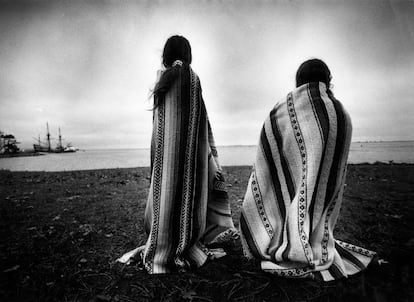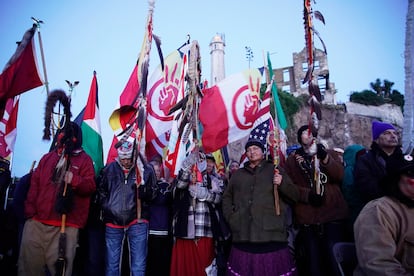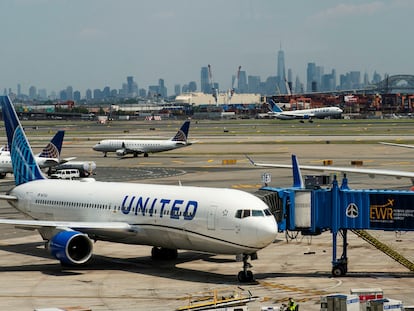Thanksgiving and Native Americans: a complicated history
For many Native Americans, Thanksgiving is a day of mourning and protest, so they have developed their own events for that date

There is a common tale that American students hear about the first Thanksgiving celebration: a group of friendly Native Americans welcomed the Pilgrims to the continent, taught them how to live, and sat down to dinner with them. However, David Silverman, an expert on the history of this population, claims that this Thanksgiving story is a myth. First of all, the tribe involved is almost never identified and, according to the myth, “they give America to whites so they can create a great nation dedicated to freedom, opportunity and Christianity so that the rest of the world can benefit. This is about natives giving in to colonialism,” Silverman argues in his book This Land Is Their Land. The truth is different.
The colonists, known as Pilgrims, arrived in 1620 in what is now Plymouth, Massachussetts, a land abandoned by most Patuxet Indians due to a disease outbreak. After a harsh winter that claimed half of the settlers — who couldn’t adjust to the land — the last surviving Patuxet, Tisquantum (also known as Squanto), helped the Pilgrims by teaching them to catch eel and grow corn. He served as an interpreter until succumbing to the same disease that wiped out his tribe a year later. The Wampanoag leader, Massasoit, who also lived in the surrounding area, provided food to the colonists during the challenging first winter.
The Pilgrims celebrated their first harvest in 1621, likely between Sept. 21 and Nov. 11, with 50 Mayflower passengers and 90 Native Americans. This feast, not initially identified as Thanksgiving, followed the harvest and was prepared by Pilgrim women and servants.
According to some accounts, the harvest was intended for the Pilgrims, but Native Americans joined the celebration after hearing celebratory gunfire, contributing their own foods. Paula Peters, historian for the Mashpee Wampanoag of Cape Cod, contends this: “They weren’t Pilgrims and the Wampanoag weren’t invited”. She points at settler accounts that say that the Pilgrims (also called Separatists) were celebrating their first harvest by blasting muskets, which caused “90 Wampanoag to arrive for war”, however, after learning they weren’t going to face a battle, “they stayed for a tense, diplomatic meal that may or may not have included turkey”.
However, the relationship between the two societies later deteriorated and culminated in “one of the most horrific colonial Indian wars on record,” King Philip’s War, according to Silverman. In the years that followed, the settlers committed massacres against Native tribes like the Pequot, and they also robbed Wampanoag graves and stole food from them to survive during their first years in the continent. This is the reason why Native Americans don’t see Thanksgiving as a celebration, but as a day of mourning, to remember what some call the genocide of natives tribes in America.
National Day of Mourning
The National Day of Mourning is an annual demonstration that aims to educate the public about Native Americans in the United States and to dispel myths surrounding the Thanksgiving story in the United States, as well as to raise awareness toward the struggles faced by Native American tribes.
In 1970, the Commonwealth of Massachusetts held a commemorative Thanksgiving celebration on the 350th anniversary of the landing of the Mayflower. The organizers invited Frank “Wamsutta” James, leader of the Wampanoag Tribe of Gay Head and president of the Federated Eastern Indian League, to speak at the event. However, after reviewing his speech, he was informed that he would not be allowed to give the speech as written, and they provided him with another one written by their public relations team.
James instead delivered his speech on Cole’s Hill in Plymouth Massachusetts next to a statue of Massasoit Sachem (also known as Ousamequin), who was the leader of the Wampanoag at the time of the Pilgrims’ arrival and who formed an alliance with the colonists at Plymouth Colony. There, he described Native American perspective on the Thanksgiving celebrations. The speech included the following statement:
“We forfeited our country. Our lands have fallen into the hands of the aggressor. We have allowed the white man to keep us on our knees. What has happened cannot be changed, but today we must work towards a more humane America, a more Indian America, where men and nature once again are important; where the Indian values of honor, truth, and brotherhood prevail (...) Now, 350 years later it is a beginning of a new determination for the original American: the American Indian.”

After the event, a plaque was put on Cole’s Hill in Plymouth with the following message:
“Since 1970, Native Americans have gathered at noon on Cole’s Hill in Plymouth to commemorate a National Day of Mourning on the U.S. Thanksgiving holiday. Many Native Americans do not celebrate the arrival of the Pilgrims and other European settlers. To them, Thanksgiving Day is a reminder of the genocide of millions of their people, the theft of their lands, and the relentless assault on their culture. Participants in National Day of Mourning honor Native ancestors and the struggles of Native peoples to survive today. It is a day of remembrance and spiritual connection as well as protest of the racism and oppression which Native Americans continue to experience.
The annual event is organized by the United American Indians of New England.
Unthanksgiving day
The Indigenous Peoples Sunrise Ceremony, also known as Unthanksgiving day, is an event held on Alcatraz Island in San Francisco Bay. It is commemorated the same day as Thanksgiving and the National Day of Mourning since 1975 to remember a protest event held in 1969, where the Alcatraz-Red Power Movement, a social movement led by Native American youth, occupied the island.

In 1969, Native American members of the Alcatraz-Red Power Movement, part of the Indians of All Tribes (IAT) group, occupied Alcatraz Island based on the 1868 Treaty of Fort Laramie, which allocated surplus government land to Native Americans. The occupation lasted for 19 months, from November 20, 1969, to June 11, 1971, when it was forcibly ended by the U.S. Government. This inspired protests by the American Indian Movement (AIM). AIM members who painted Plymouth Rock red during a Thanksgiving protest in 1970, leading to the establishment of the National Day of Mourning.
The event is organized by the International Indian Treaty Council.
Sign up for our weekly newsletter to get more English-language news coverage from EL PAÍS USA Edition
Tu suscripción se está usando en otro dispositivo
¿Quieres añadir otro usuario a tu suscripción?
Si continúas leyendo en este dispositivo, no se podrá leer en el otro.
FlechaTu suscripción se está usando en otro dispositivo y solo puedes acceder a EL PAÍS desde un dispositivo a la vez.
Si quieres compartir tu cuenta, cambia tu suscripción a la modalidad Premium, así podrás añadir otro usuario. Cada uno accederá con su propia cuenta de email, lo que os permitirá personalizar vuestra experiencia en EL PAÍS.
¿Tienes una suscripción de empresa? Accede aquí para contratar más cuentas.
En el caso de no saber quién está usando tu cuenta, te recomendamos cambiar tu contraseña aquí.
Si decides continuar compartiendo tu cuenta, este mensaje se mostrará en tu dispositivo y en el de la otra persona que está usando tu cuenta de forma indefinida, afectando a tu experiencia de lectura. Puedes consultar aquí los términos y condiciones de la suscripción digital.
More information
Archived In
Últimas noticias
From Andorra to Gibraltar, a black market for Ozempic exploits its success: ‘They’re the most sought-after products in the world’
Magnets in their heads: How some animals guide themselves using the Earth’s magnetic field
From Hungary’s Orbán to Chile’s Kast: How Trump helps turbo charge the far right
The brief rise and retreat of Generation Z in Mexico
Most viewed
- Why we lost the habit of sleeping in two segments and how that changed our sense of time
- Trump’s obsession with putting his name on everything is unprecedented in the United States
- Charles Dubouloz, mountaineering star, retires at 36 with a farewell tour inspired by Walter Bonatti
- The Florida Keys tourist paradise is besieged by immigration agents: ‘We’ve never seen anything like this’
- Living in a motorhome due to soaring housing prices in Madrid: ‘I got used to it quickly, but I don’t idealize it’











































